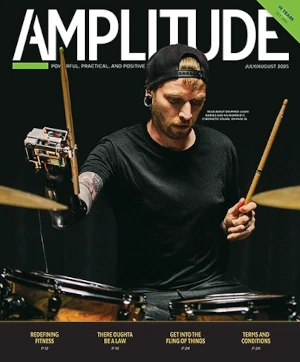Yoga improves your balance, flexibility, core strength, mental health…need we say more?
Is amuptee yoga officially a thing yet? It’s certainly not anything new; amputees have been practicing yoga for decades. But they’ve largely learned it from able-bodied instructors, via classes and books and videos designed for able-bodied participants.
As recently as three years ago, Marsha Therese Danzig (who we introduced you to last month) was the only widely known amputee yoga teacher. She’s still the dean of the discipline (see below), but she’s no longer alone. Lately another half-dozen or more amputee yogis have started sharing their tricks and techniques on social media and in person (if you can remember such a concept). In addition, able-bodied yoga teachers are flocking to trainings where they can learn amputee-friendly techniques to better serve their limb-different clients. Prosthetic clinics here and there are offering yoga classes for their clients. There’s even a recent Ph.D. dissertation making the rounds, examining yoga’s effects on amputee health.
It sure sounds like a thing to us.
While its physical benefits include better balance, flexibility, and core strength, yoga may reward amputees more richly in the mental and emotional/spiritual realms. Enthusiasts say it alleviates depression and anxiety, eases PTSD, and promotes overall serenity. For amputees in particular, it can promote self-acceptance. As Danzig puts it, “Wholeness is not simply having four limbs. Wholeness is knowing you are complete within yourself just as you are.”
We can’t claim completeness for the following list of amputee tree posers, crescent lungers, and sun salutationers. (Apologies to anybody we’ve left off—send email to editorial@livingwithamplitude.com and we’ll add you to the article.) But it’s a start, anyway. Whether you’re a novice or a longtime practitioner, all these amputee teachers can introduce you to yoga or lead you to the next level.
MARSHA DANZIG
Danzig took up yoga a few years after losing her left leg below the knee to cancer at age 13. She’s kept at it for three decades, despite serious kidney disease, failure, and eventual transplant. In 2008 she gave her first yoga workshop specifically for amputees, and it has since blossomed into a full-time gig and multimedia mini-empire. You can find Danzig on Facebook, YouTube, and Burnalong, at national conferences and healthcare training clinics, and at the head of the Amputee Yoga Association. She’s starting a new series of weekly online classes next month (sign up here) and continuing to train able-bodied yoga pros to work with amputees. Danzig’s 2018 book, Yoga for Amputees, is still essential reading and the only volume of its kind that we’re aware of.
KIRA BRAZINSKI
Brazinski was the subject of last year’s award-winning A Grand Journey, documenting her attempt to summit Grand Teton. A native and current resident of Jackson’s Hole, she teaches in person and online at Inversion Yoga (online schedule here). Keep an eye on her Facebook and Insta feeds, too, for yoga tips and occasional one-off classes and live sessions.
MELANIE WALDMAN
An upper-limb amputee, Waldman recently launched a new series of live weekly yoga classes on Facebook. They’re low-key, accessible, and super welcoming for folks of all abilities. There’s a lot more to her story; find out about it from our recent brief.
STEVE JOHNSON
We learned about Steve Johnson from Jennifer Johnson (no relation), a bilateral above-knee amputee (BAKA) who says yoga was the catalyst that helped her resume healthy, happy living after amputation. Johnson’s Milwaukee-based studio, Inner Ability Yoga, hosts periodic events on Facebook Live. Check the schedule to see what’s coming up next.
ACCESSIBLE YOGA PROJECT
Accessible Yoga trains yoga teachers to work with amputees, wheelchair users, trauma survivors, and other adaptive participants. This high-profile nonprofit primarily teaches via in-person conferences and trainings, but it’s offering its first-ever online course next month. To be clear, Accessible Yoga caters to yoga teachers who already hold or are seeking certification; it’s not aimed at beginners or even serious practitioners. But if you’re looking for a teacher, or just want to stay current about adaptive yoga techniques, it can be a good resource.
KELSEY KOCH
Not that long ago, Self magazine touted Koch as “the amputee changing the face of yoga.” She scored a space to open her own studio (Serenity Yoga) in Michigan and was included in a Reebok marketing campaign. But between the pandemic and a completely unrelated chronic health issue, this has been a tough year for Koch. Due to her serious vulnerabilities to COVID-19, she’s been forced into strict lockdown mode, putting everything on hold. “We are all abled,” Koch writes at her website. “Able to be kind, passionate, loyal, optimistic and able to achieve anything we set our minds to.” She’s living up to those words despite everything. Watch her Instagram feed for updates.
DAN NEVINS
A bilateral below-knee amputee who lost his legs in Iraq, Nevins credits yoga with calming his mind. He periodically hosts live sessions on Facebook (here’s his page), and we found one YouTube video to give you a sense of how Nevins teaches yoga. Before he became a certified yogi in 2015, Nevins joined a couple of other wounded warriors on a trek to the top of Kilimanjaro. Learn more at his website.
LINDA WILLIAMS
We can’t find much information about Williams, an LAKA. All we know is she has a helpful series of about 15 demo videos at YouTube, including how-tos for some fairly ambitious poses.




